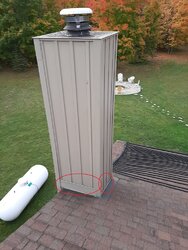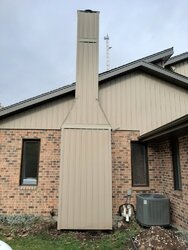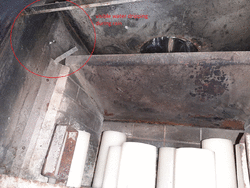Hi,
I noticed that during rain, there is water leaking into my wood-burning fireplace. The chimney is covered entirely in vinyl. I went on the roof with a hose and systematically sprayed areas from the bottom up, stopping to check whether it caused a leak in the fireplace each time. Based on this, I am fairly certain that the water is entering when I spray the vinyl siding itself. See the attached pictures with red circles around the suspected area. After thinking about it, I hypothesize that the vinyl siding should not be running down into a "j" channel piece at the bottom, where it meets the roof. Would this not be causing any rain to run down the vinyl, getting trapped in the j channel, and then subsequently sitting and entering into the chimney itself? Would the solution be to modify this in some way so that the siding overlaps the j channel (or remove the channel entirely?) so that water will flow freely down the side of the chimney to the metal flashing on the roof itself, where it would then just run off the roof and not leak into the chimney?
I am posing these questions in case anyone has any experience in this, as it appears to me that the vinyl should not have been installed this way, effectively creating a trap for water runoff from the exterior chimney itself, and an inevitably entry point into the chimney. If this is the case, I would need to fix it on the roof, and also various points in the vinyl along the entire chimney (see attached).
The top of the chimney appears ok, and overhangs an inch or so over the siding. In fact, when I did the hose test, I didn't even spray up there. Water starting dripping into the fireplace after I sprayed the siding itself, so I stopped testing at that point (i.e., didn't spray the top of the chimney.
Any insights would be appreciated!
I noticed that during rain, there is water leaking into my wood-burning fireplace. The chimney is covered entirely in vinyl. I went on the roof with a hose and systematically sprayed areas from the bottom up, stopping to check whether it caused a leak in the fireplace each time. Based on this, I am fairly certain that the water is entering when I spray the vinyl siding itself. See the attached pictures with red circles around the suspected area. After thinking about it, I hypothesize that the vinyl siding should not be running down into a "j" channel piece at the bottom, where it meets the roof. Would this not be causing any rain to run down the vinyl, getting trapped in the j channel, and then subsequently sitting and entering into the chimney itself? Would the solution be to modify this in some way so that the siding overlaps the j channel (or remove the channel entirely?) so that water will flow freely down the side of the chimney to the metal flashing on the roof itself, where it would then just run off the roof and not leak into the chimney?
I am posing these questions in case anyone has any experience in this, as it appears to me that the vinyl should not have been installed this way, effectively creating a trap for water runoff from the exterior chimney itself, and an inevitably entry point into the chimney. If this is the case, I would need to fix it on the roof, and also various points in the vinyl along the entire chimney (see attached).
The top of the chimney appears ok, and overhangs an inch or so over the siding. In fact, when I did the hose test, I didn't even spray up there. Water starting dripping into the fireplace after I sprayed the siding itself, so I stopped testing at that point (i.e., didn't spray the top of the chimney.
Any insights would be appreciated!




